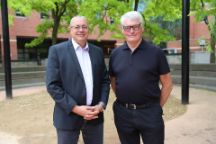$5.2M green energy research hub coming to Swinburne

The hub will be a test bench for researchers and industry to work together on meaningful solutions for greener, more efficient future energy systems.
In summary
- In collaboration with global tech leader Siemens, Swinburne is building the $5.2M Energy Transition Hub at the Hawthorn campus
- The research-driven hub is focused on energy and sustainability
- It will be open to industry and institutional collaborations that can take research ideas from the lab into industry
Australia’s new research-driven hub focused on energy and sustainability is coming to Swinburne’s Hawthorn campus in 2023. Created in partnership with global tech leaders Siemens, the $5.2M Siemens Swinburne Energy Transition Hub will drive collaboration between researchers and industry.
Accessible to students and industry, the hub will feature a future energy grid laboratory with some of the most advanced digital energy technology from Siemens.
The hub will enable users to create digital twins of energy grids, map scenarios, research new findings, develop original and creative hypotheses, and test results.
“We are incredibly excited about this new collaboration with Siemens, who has partnered with Swinburne over many years to share in our vision of people and technology working together to build a better world”, said Deputy Vice-Chancellor Research Professor Karen Hapgood.
“Australia’s ambitious carbon reduction targets need a multipronged approach by industry, research and government. The new Siemens Swinburne Energy Transition Hub will be working on new technologies to improve efficiency, supply, integration, storage, transport and use, as well as how we can improve existing technologies and frameworks.
"We need change fast, and the Siemens-Swinburne team will focus on taking ideas to market – where they can make the most impact as quickly as possible.”
Working towards a greener future
The hub will act as a tech bench for researchers and industry to work together on meaningful solutions for greener, more efficient future energy systems. It will be home to a digital twin of Australia’s energy market and it enables commercial-research teams to run simulations of new solutions.
“Our relationship with Swinburne University of Technology is long-standing and we’re proud to extend it through the new Siemens Swinburne Energy Transition Hub," said Peter Halliday, CEO and Chairman, Siemens Australia and New Zealand.
"Collaboration between industry and academia is critical to driving better outcomes on key topics of national importance such as energy transition. Digitalisation allows you to do more with less as technology assists you in identifying the opportunities for reducing energy consumption and emissions.”
New opportunities
As a collaborative research facility, the hub will be open to industry and institutional collaborations that can take research ideas from the lab into the industry – so they can make an impact, now.
“Bringing an industry-led Energy Transition Hub to Swinburne will create a high-end laboratory space to undertake cutting-edge research designed to meet industry needs and help address the global challenge of energy transition," said Director of the Siemens Swinburne Energy Transition Hub and Swinburne researcher, Associate Professor Mehdi Seyedmahmoudian.
"The hub aims to conduct high-impact industry-led R&D projects in line with Australia’s carbon reduction targets. It will also offer new opportunities for Swinburne students and industry professionals looking to upskill for the next generation of energy technologies and future electrical networks.”
In addition to research and development and commercialisation projects, the hub will deliver short courses for industry professionals.
It will also give back to Swinburne students, with Siemens software and the company’s real-world industry experience integrated into engineering technology courses. The hub will feature access to software and hardware products straight from Siemens Grid Software portfolio.
“We are thrilled to be using leading technology from Siemens’ Grid Software portfolio to test new, creative solutions through digital simulation, allowing for faster and more efficient commercialisation, where advances in energy tech and renewable energy integrations can do the most good: on the grid and in our homes,” said Dean of Swinburne’s School of Science, Computing and Engineering Technologies, Professor Alex Stojcevski.
-
Media Enquiries
Related articles
-

- Sustainability
Expert opinion: Nuclear power has ‘merits’, but investing in renewables ensures long-term energy security
The opposition is promising to build seven nuclear power stations but a Swinburne expert says it's possible to transition our energy system without relying on nuclear power.
Wednesday 19 June 2024 -

- Technology
- Science
- Sustainability
- Engineering
CSIRO and Swinburne invest in green steel and mineral processing to help industry get to net zero
CSIRO and Swinburne have established a new partnership to tackle global decarbonisation with innovative green steel and mineral processing research and development.
Thursday 01 February 2024 -

- Trades
- University
- Sustainability
Transforming Indigenous housing with future-forward solutions
Swinburne University of Technology has launched a new Indigenous Building Co-Fab initiative. The initiative will tackle housing affordability and sustainability by creating innovative pathways to upskilling communities themselves.
Tuesday 19 December 2023 -

- University
- Sustainability
French and Australian governments announce new partnership to tackle global energy crisis
Swinburne University of Technology will host a historic new partnership between France and Australia, FACET: the French-Australian Centre for Energy Transition.
Friday 08 December 2023 -

- Sustainability
- University
Green partnership to accelerate Swinburne’s research impact
Swinburne has partnered with Twynam’s Earth Fund to drive the commercialisation of decarbonisation research, accelerating the university’s innovation ecosystem.
Tuesday 21 November 2023

